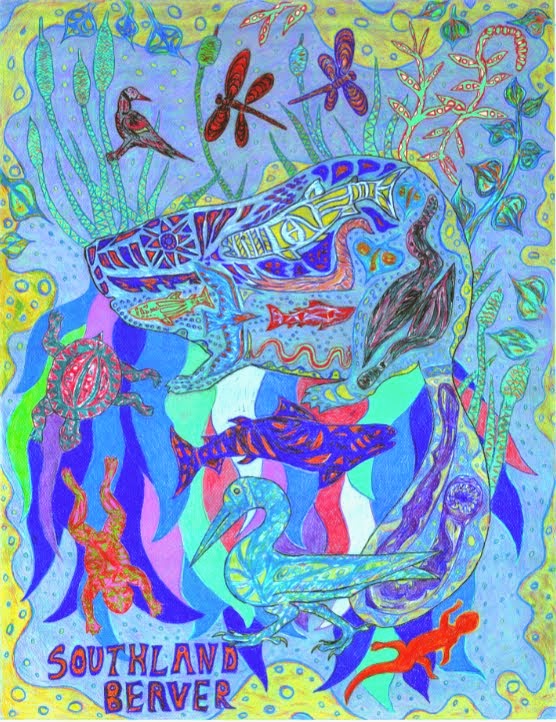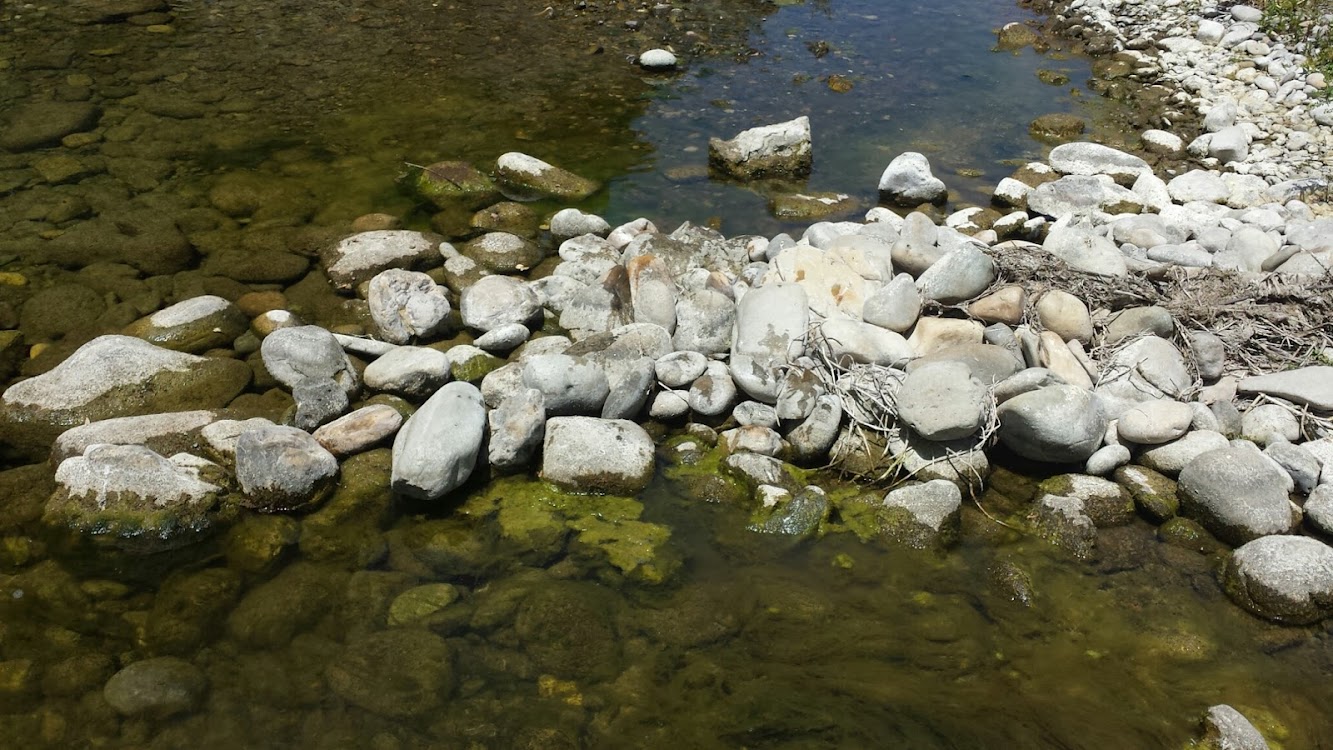For some comparison below is what the river looked like last September during the water release at the same spot.
Water makes quite a bit of difference does it not? One of the benefits of a largely dry river is it gave me a chance to investigate and get into places that I suspected were beaver ponds but were difficult to reach during high water. For instance in the wet picture you can see a little side pond which I suspected was beaver constructed. But instead of a full on dam the ingenious engineers had simply diverted off a side channel of the river, bermed it up and willows/vegetation grew over the beaver constructed water works. When I walked along the berm I found some old beaver gnaw marks as seen below...
But does this drying river, remember it is only the end of April, forebode danger for the beaver population on this river? Well as I mentioned earlier there is a good chance for a senior water rights release later this year but regardless there were pools further upriver that were full of water and may indicate refugia for beaver and other aquatic/amphibious critters. And there is much to suggest that beaver are a lot more adaptable when it comes to changing capricious water conditions than might be generally expected. Looking upriver from Alisal bridge (Solvang) things looked a little bit more promising with regards to water.
Again though, for reference, below is the pic I took in September last year during the water release.
In fact if you look at the little side pond to the left, where it gets a few feet deep I found a western pond turtle- a threatened species -on this trip. So life was finding ways to hold on during this dry spell.
Western pond turtles of course are a species that I have often posited would benefit greatly through beaver habitat as they prefer slower, more relaxed bodies of water to inhabit. Going a little further upriver I came across a fairly large pool- deep enough to swim in - against a steep oak shrouded hill. There was one particular spot I was interested in, the deepest spot, because on the steep bank there was dense brush and felled trees. It looked like the perfect place for beaver to dig a secluded bank burrow and I would highly suspect that they do here.
Now one thing you will notice in the video are a couple of little rock dams both downriver and upriver from this spot. I did not think too much of them at the time, figuring they looked man made. But what if beaver made the little rock dams? Perhaps these rocks are just the foundation for a future dam? One thing I noticed during this visit as opposed to the last visit was that fresh beaver activity on trees was not found. Maybe the beaver, feeling restricted to the few big pools left were not venturing out to fell/or feed on trees but were staying close to these deep water refugia and feeding more on the aquatic plants/algae growing abundantly there? The more I explored the more I found evidence supporting my theory.
Weird hugh? I mean hikers all the time make such features to cross streams and there are people that go down here. But if these rock berms were made by people why two of them right after each other? And there is no trail on the other side just thick bush... Maybe these beaver just really like rocks?
Anyways, rock-working beaver aside I continued upriver to a spot where I knew of some nice beaver ponds in a maze of sedges and willow thickets. Last time I went here these ponds were waist deep and just really cool to explore. This time it was a little bit different...
Yep this beaver maze was a shell of it's former self. And there literally were tons of shells lying around from Louisiana crayfish that were consumed en masse after the ponds dried up. I bet raccoons were some of the main culprits but I saw loads of marauding great blue herons and great egrets just slurping up whatever critters were left in the last muddy pools. One slimy mud pool was interesting because it was dominated by bullfrog tadpoles. If you have not seen bullfrog tadpoles they are not your normal everyday polliwogs and are pretty big and ugly, just like the adults. Anyways I will talk more about the issue of invasives utilizing beaver ponds in a future post so I will save that stuff for later.
Yes I know the below pics are a little depressing but I have faith the beaver have seen this happen before and know how to adapt. But you can see some nice and very obvious dams and the ponds that they would have created.
Where do the beavers go when their ponds dry up? The vegetation may offer a clue. The above chewed willow stump, like the earlier pic, is obviously not a fresh chew. And as I mentioned earlier I saw no freshly chewed trees on this safari. This is in sharp contrast to my last excursion when I saw so many freshly chewed trees that I stopped photographing them. And while there was no fresh chew on trees I did see some uprooted sedges, with their rhizomes chewed off, a well known beaver treat. And not to far from the dried up beaver ponds I found another large, deep pool. Likely retaining water due to shallow bedrock forcing groundwater up here I suspected this pool may serve as a beaver refugia. And then I saw a pretty obvious trail through the emergent water plants which grew in abundance here.
Were does this trail lead to? A pool with some deep spots bordered by a relatively steep bank. And guess what I found when I investigated the bank. Some very probable and likely beaver bank burrows.
You can see one that enters at the water level and another slightly obscured at the upper right. I also went and filmed two other potential beaver burrows as seen in the video below.
So I think I have got a pretty good grasp on how beaver utilize the Santa Ynez river, or at least a fairly good working hypothesis.
During periods of high flows and water releases beaver are able to utilize more of the riparian area safely and efficiently. These times may also coincide with the greatest dam building activity. Tree felling and consumption is relatively high as beaver are never too far from the safety of water. Indeed sometimes the trees are growing in the water.
During periods of low or no flows, a shift of range and diet occurs. It is well known that many beaver switch to a diet of succulent sedges/water plants/algae during summer months. For the beavers of the Santa Ynez such a change may be less of a choice but a matter of necessity. Because large, deep pools are at a premium and such pools withdraw away from the riparian edges where such trees grow- tree felling and consumption places a significant risk to predation to beavers as it pulls them away from deep water and is a relatively noisy and cumbersome affair. Instead beaver concentrate on algae/aquatic vegetation and remain as cryptic as possible due the relative lack of water cover.
Steep banks of alluvial soil bordering perennial, deep pools may offer critical refugia for beaver living in this habitat especially during times of low flow.
Such conditions, steep alluvial banks bordering deep, perennial pools, may offer another set of criteria when looking at potential sites for beaver restoration in arid habitats.
Cheers!!
Support me on Patreon.
Like antediluvian salad on facebook.
Watch me on Deviantart @NashD1.Subscribe to my youtube channel Duane Nash.
My other blog antediluviansalad.blogspot




















FYI - kids build dams too in the river all the time while swimming, rafting and playing in the river.
ReplyDeleteYes but I did not see any evidence of children/kids here. No trash, beer bottles etc. And the water was too low/murky/algae ridden to really invite bathers. Also a little inaccessible.
DeleteDroughts are natural phenomena, but I sometimes feel sad and guilty because we might have had a hand on why climatic tragedies like these happen. Add that to the fact that it's also affecting the animals in the wilderness, which are more vulnerable, in a way. Good thing that they can adapt though, as exemplified by your description of how beavers survive in arid habitats. The pictures are quite good, by the way. You've got a quite interesting blog here and I think I'll stick around to read more.
ReplyDeleteLorenza Coon @ Central Basin